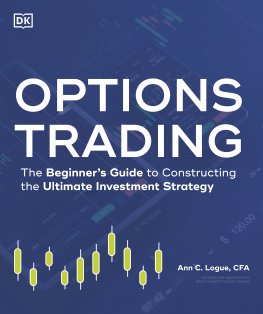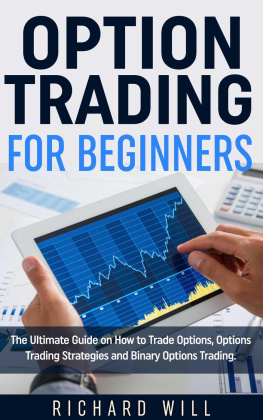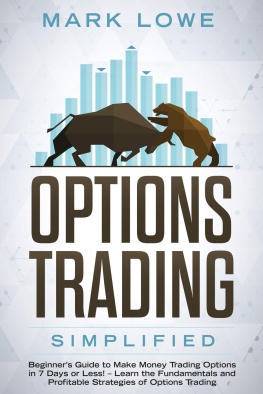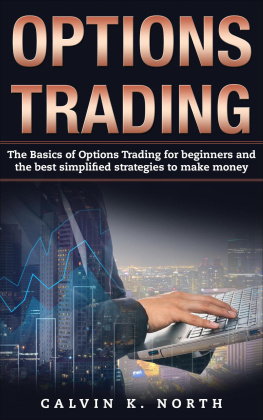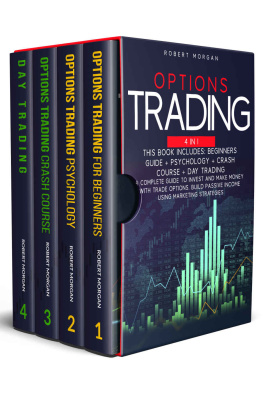Options Trading For Beginners:
Tips, Formulas and Strategies For Traders to Make Money with Options
By
Dale Blake
Table of Contents
Options Trading For Beginners: Tips, Formulas and Strategies For Traders to Make Money with Options
By Dale Blake
Copyright 2015 Dale Blake
Reproduction or translation of any part of this work beyond that permitted by section 107 or 108 of the 1976 United States Copyright Act without permission of the copyright owner is unlawful. Requests for permission or further information should be addressed to the author.
This publication is designed to provide accurate and authoritative information in regard to the subject matter covered. This work is sold with the understanding that the publisher is not engaged in rendering legal, accounting, or other professional services. If legal advice or other expert assistance is required, the services of a competent professional person should be sought.
First Published, 2015
Printed in the United States of America
Introduction
You must have seen it on television commercials or full page adverts in newspapers and journals or have been emailed by someone regarding get rich quick promises. All one is required is to have some stated amount of dollars and attend some conference. Rub off this notion since it is not the best way to learn about the benefits of trading in options. Options trading is a difficult subject when compared with other forms of investment, for instance stocks. Therefore, many people shy away from getting into options trading. However, there is a good number of potential investors who need to acquire more information before getting involved in trading options. In their learning, however, sheer determination and effort is paramount and will determine ones success in the long run.
Although the subject is difficult to learn, nothing is too complex to an extent that its basics cannot be understood. Learning about the basics of options provides a base for further grip on deeper aspects of what actually takes place and that will eventually make sense. Trading in options allows the investor to reduce risk and have an improved chance of a gain in the stock market. However, it is essential to understand the operation of options before investing in them.
Chapter 1. Basics of Trading Options
What is an Option?
After a bit of introduction to options, you mind may be ringing questions like, what are options and why would someone invest in them?
An option is a binding contract to buy or sell a distinct financial instrument usually referred to as options underlying interest. It is a precise contract and is established at particular price at which an agreement is arrived. This price is called the strike price. Besides, an option is time bound and has an expiry date. Beyond this date, the contract ceases to exist.
Options are of two types namely; calls or puts with both types having the ability to be sold or bought. Regarding this, you can choose to buy or sell or choose a call or put depending on your goals as an investor. For instance, in a scenario where one buys a call option, then he has the right but with no obligation to purchase a stock at the strike price before the expiry date of the option. The same applies to buying a put option where you acquire right minus obligation to sell a stock at the agreed price before the expiry of the period of investment.
To heighten the understanding about options, it is significant to differentiate it with stocks. The primary difference however, is that stocks gives you a small ownership of the company while options are binding contracts that gives you the right to sell or buy the stock at an agreed strike price within specified dates. Since it involves either buying or selling, two parties are involved.
What is a Call Option?
This is the option to buy the underlying stock at an agreed price (strike price) before a predetermined date (expiry date). The buyer of the call holds the right to purchase the stock within this period while the seller (writer) has the obligation. If the call buyer makes a decision to buy the option (exercising the option) then the seller is expected to sell the stock to the call buyer at the strike price.
An example on this will deepen the grip. Say, a trader bought a call option at a certain company at $40 expiring in three months. The call buyer possesses the right to exercise that option paying the agreed strike price of $40 per share and receiving the shares. The call seller has an obligation of transferring the ownership of the shares and should be contented with the $40 he/she is receiving.
What is a Put Option?
Having known more about a call, one can unsurprisingly predict correctly what a put option is. This is the agreement between two parties where one has the right to sell the other at a predetermined strike price shares and the other party is obliged to buy them at that price.
Consider a case where investors bought shares of a company that has been financially healthy in the past two years. They believe that the company might continue doing well but perhaps in the verge of economic slowdown and might soon decline in the market thus they buy put option at a strike price of $50 to protect their gains. Here, buyers of the put option possess the right to sell their stock at $50 until the expiry date. The sellers of the put are obliged to purchase the shares at the agreed price of $50 which could hurt should there have been a decline in the price beyond this price.
Why are Options Relevant?
One may not see the sense brought about by the content already discussed. Well, this is a profit making business for instance; a call buyer would hope that the prices of the stock invested would rise so that he/she makes a profit. The call writer on the opposite side hopes that the share price declines such that it should be at least less than the amount received when entering the contract.
Similarly, the put buyer gains when the share price declines. A put rises in value when the initial stock price falls. Conversely, the writer of a put hopes for the option to expire with the share price above the strike price or an allowance for the stock to decline only up to the amount they gained from selling the put.
From the above therefore, we realize that options are tradable securities and can lead to profit and loss. There are many benefits on trading in options such as:
1. Options traders can profit in flat markets.
2. Options act as cover or insurance to invested stock that is unstable by pooling of risks.
3. Trading in options can triple your money overnight.
4. They can also be used to source steady flow of income from portfolios of blue chip stocks.
What is a Premium?
When you buy an option, the price incurred is called a premium. If you sell, the amount received is also referred to a premium. This premium is not fixed and changes with time. This implies that the premium you pay or receive today will not be necessarily the same as that which will be paid or received for the same options tomorrow. This price is reached by an agreement between the seller and the buyer.
Volatility
This is the tendency of the price of the tradable securities to fluctuate either to rise or fall. It portrays the extent of price fluctuation rather than the direction of the movement of the price. Therefore, premiums play a great role in the volatility of prices of options. Thus, the more volatile the underlying stock may be imply a higher premium. A general statement will therefore suggest that volatile stocks attract higher premiums for both calls and puts with the reverse being true.
Chapter 2. Options Strategies
Having introduced the two types of options which are calls and puts; it has been illustrated that there are two sides to an option transaction which are the buyer and the seller. We have discussed how volatile the prices may be and how they are set. Options strategies implies tying concepts that affect price of the stock together in a graph of profit and losses.
Next page

